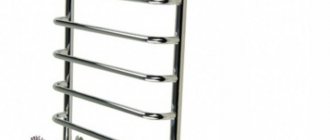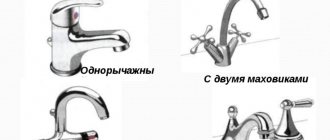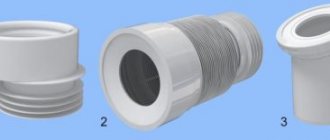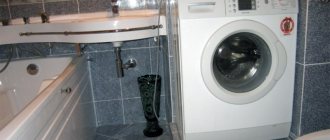A heated towel rail is not just a useful, but also a convenient device that allows you to heat your bathroom. In addition to the useful functions it performs, the heated towel rail must have a beautiful appearance so as not to spoil the interior and maintain it in perfect condition. To do this, the heated towel rail in the bathroom is painted.
Before starting work, you need to prepare the necessary materials and tools. Let's consider the sequence of painting work.
What you need for painting
To carry out the work of painting a heated towel rail in the bathroom as quickly as possible, prepare yourself :
- sandpaper;
- flute brush (narrow and wide) or roller;
- primer;
- detergent (or solvent);
- gloves;
- putty knife;
- rags for wiping away stains;
- screwdriver or set.
Since the dryer gets very hot during operation, a special paint is required for application (standard paint for walls, floors and ceilings will not work, it quickly cracks and falls off the surface of the pipes).
For coating heating radiators and heated towel rails, the optimal choice is silky-glossy enamel, which can withstand temperatures up to 180-220 degrees.
Main types of paints (average cost 150-170 rubles per 1 liter):
- Alkyd enamel is resistant to negative influences in the form of constant temperature changes. It has an unpleasant odor, which is especially noticeable when the surface dries.
- Acrylic enamel - looks beautiful, comes in many colors, and is durable.
- Water-dispersion paint - dries quickly, absolutely safe for the human body, long service life.
The color of the enamel is chosen to match the interior and depends on individual wishes. Chrome paint for heated towel rails is very popular, adding a touch of chic to the interior. Bronze or gold shades can also be used - they look beautiful and rich.
Beautiful shades can be created using paints of greenish, bluish and beige (pink) colors.
It is not recommended to use white enamel. At first it looks beautiful, but after six months the aesthetic appeal will be lost. The pipes and heated towel rail will turn a pale yellow color due to constant temperature fluctuations.
Preparatory work
The effectiveness of the entire work will depend on the quality of preparation: if the product is not given ideal smoothness, the paint will not be able to adhere to its surface.
Cleaning the base
The old coating must be completely removed so that no paint or varnish remains. This can be done with sandpaper or a metal brush, but if you have an angle grinder or a grinder, the work will go much faster. Professionals often use sandblasting machines to remove paint from metal. A chemical remover or a hot air gun are also suitable for this purpose.
Before carrying out preparatory work, put on gloves, goggles, and a respirator. Organize good ventilation of the room or clean the heated towel rail in the open air.
They act this way:
- Clean off the loosest pieces of paint, removing them in layers.
- Use sandpaper to work out cracks, corners, and bends.
- Corrosion elements, if any, are removed especially carefully.
- Wash the heated towel rail with water and detergent, removing all the smallest particles of paint and dirt and assessing the result.
- The metal is cleaned again if untreated areas are identified.
- Dry the base, then wipe it with a degreaser.
- If there is rust on the metal, apply an anti-corrosion compound to all surfaces.
Heated towel rail primer
Priming is the final stage of preparing a heated towel rail for painting. You need to choose the soil carefully, because it must also be resistant to elevated temperatures and well suited for metal surfaces. It is best to buy an alkyd primer and apply it in a thin, even layer. After drying, you need to repeat the process again.
Coloring
There are usually no difficulties with painting; all work is done using a brush:
- Mix the paint thoroughly until it has a uniform consistency.
- Gently dip the tip of a narrow brush into the paint and apply it to the upper areas of the heated towel rail - this will help avoid drips and drips.
- Completely paint the product and allow the material to dry (usually 2–3 hours).
- Repeat painting 1-2 more times.
- After 4–5 days the coil is put into operation.
Instead of a brush, you can use a small spray bottle. It will allow you to apply the product without streaks, in a strictly uniform layer, and there is no risk of hairs appearing on the surface of the product.
Spray paint should be thinner than when using a brush, so you need to add a little thinner to it.
Painting of metal, galvanized and polymer pipes - features
The main thing when painting a metal heated towel rail and pipes is to thoroughly clean the surface not only of old paint, but also of rust. Anti-corrosion treatment cannot be ignored: a new source of rust will quickly begin to form under the paint, and the paintwork will begin to snap off.
Galvanized pipes usually do not require painting because they have a durable protective layer on the surface. But if it is necessary to stylize the heated towel rail, it can also be treated with an alkyd or silicone composition of the desired color. Before applying it, be sure to prime the base: without this, the quality of adhesion will be greatly reduced. Before painting, you need to check that there is no condensation on the item.
Polymer products are also painted only for the purpose of making changes to the interior of the room, while the work does not require anti-corrosion measures, but priming is mandatory. For plastic, paints without acetone or other aggressive solvents are used.
Preparing the heated towel rail
Painting a heated towel rail bronze or any other color requires preliminary work . If a thin layer of enamel is applied to its surface, the surface will remain imperfect, and after a while rust may appear on it.
Use sandpaper to remove the top decorative layer throughout the dryer. Carefully handle pipe bends and cracks in the old paint layer to level the surface.
Ideally, if you want to beautifully paint your heated towel rail in chrome or bronze, it is recommended to completely remove the entire decorative layer. If it is a chrome layer, then it must be removed completely, since the paint will adhere very poorly to it.
Removing the top layer from heating radiators and heated towel rails is a long task, but it is worth it. In the future, painting the old product will be much easier.
After removing the top layer, the dryer is thoroughly wiped with a cloth and a cleaning agent to degrease the surface and remove remaining particles from it. The next step is applying a primer to the surface of the product.
Choose a primer that can withstand high temperatures . For example, the GF-21 primer has proven itself well. Also suitable are NOVA and CO primer enamels and Eckart. Apply them in a thin and even layer. Then leave the heated towel rail to dry for 3-4 hours.
Choosing a coloring agent
Pipe paint plays a big role in repair work. The modern market offers a wide selection of paint and varnish products. Coloring agents most often used to treat heating elements:
It must be remembered that when painting pipes, you should follow the instructions for the coloring agents, and also work with gloves and using special brushes.
Heating systems in the bathroom need painting once every 2-4 years. During repair work, painting of pipes is carried out at the last stage. The paint can be applied with a brush, spray or roller. Batteries can be processed over old layers, but only if they are undamaged and smooth. Even if there are small cracks or bulges, you will have to tear off all the layers and paint the pipes again.
- Before painting, apply a primer, and it is important that the batteries are not wet. To do this, they must be wiped with a dry cloth.
- After the primer layer has completely dried, you can begin painting. The pipes need to be coated in 1 layer, it should be minimal. If the paint shows through, you will need to treat the surface twice.
- The product for painting pipes in the bathroom is applied with a spray gun or brush. Sometimes a roller is used for this process, but this tool is inconvenient to work in hard-to-reach places. Very often you have to use a special radiator brush, which can fit into any thin openings and paint the hidden parts of the pipes.
- It is better to paint heating radiators in the bathroom in the spring and summer, when the pipes are cold. Painting them in winter is also allowed, but you can get an uneven layer that will look sloppy.
- It is recommended to use only heat-resistant paints for painting, which provide a durable layer that does not emit harmful substances during heating.
- To get more warmth, you can use dark-colored dyes.
It is very simple to calculate how much paint is needed for radiators in the bathroom. Usually, the packages immediately indicate the amount of substance that is needed to treat 1 m². If there is no such designation, then you can use the formula: the length of the pipes must be multiplied by their diameter and by 3.14.
In addition, it should be taken into account that the paint is applied in 2 layers, so the resulting number is doubled. This way you get the required amount of paint for the pipes in the bathroom. If you follow all the rules for painting batteries in the bathroom, you can do it quickly and efficiently.
Painting a heated towel rail
Shake the paint thoroughly beforehand to obtain a homogeneous mass. How can you paint a heated towel rail in the bathroom? To do this, use a natural bristle brush .
Some types of enamels require mixing in several stages.
When applying paint to the surface of the heated towel rail, try to spread it thoroughly over the surface and do not allow smudges to form. Application of several layers is required , and the interval between these stages should be at least 40-60 minutes. Upon completion of painting, leave the heated towel rail to dry for a day (some recommend leaving it for 3-5 days).
Useful tips
Some useful tips on how to paint a heated towel rail in your bathroom without making mistakes.
- For painting, you can use not only a brush, but also a spray bottle. In some cases, a spray gun is the preferred choice, since it allows you to apply paint in a perfectly even layer and at the same time saves its consumption.
- Is it possible to paint a hot heated towel rail? No! It needs to cool completely. And it is not turned on until the enamel is dry. It is advisable to transfer this work during the shutdown of hot water in residential buildings.
- If the purchased enamel turns out to be too thick, dilute it with a solvent, which is sold at any hardware store.
What should the paint be like?
Do you know which open communications have the greatest length in our apartments? Of course, heating systems, and since heating pipes are a special type of surface, the painting composition must therefore meet certain requirements.
Captain Obvious informs: it is not recommended to use ordinary paint on batteries and supply pipes, since, most likely, it will not live up to expectations and will quickly become unusable.
So, what paint should you use to paint heating pipes? Among the requirements, the most important are the following:
- Lack of water permeability
. It is important that the paint functions as an anti-corrosion coating. Even if heating pipes are located in a dry room, there is a risk of rust on black steel. Properly selected paint will avoid this; - The aesthetic point is no less important
, since the color of the paint should not only not disturb the external aesthetics of the room, but also complement it. In principle, if the pipes are located in niches that will be closed in the future, then only protective properties will be required from the paint.
However, you should not hide any communication pipes with any insulating materials, as this will make it difficult to access them in the event of a breakdown;
- Since the surface of the battery is often subject to heat, one of the most important points among the paint requirements is its resistance to high temperatures. Otherwise, the coating may become yellow in the future, and cracks and delaminations may appear on the painted surface.
- It is preferable to choose paints with good adhesion to metal
, otherwise you will have to treat the surface to be painted with a primer.
Painting of metal, galvanized and polymer pipes
Metal pipes must first be cleaned of old paint and rust. A preliminary layer of primer is applied on top, which not only allows the top layer of paint to be well fixed, but also increases the service life of the pipes.
There should be no accumulated condensation on the pipes during the application of enamel. Galvanized pipes do not require painting . As for polymer ones, they are painted only to make changes to the interior of the room.
Plastic pipes are coated with paints that do not contain acetone or aggressive compounds such as NTs, ML.
Video instruction
To give plastic pipe products the desired color during their manufacture, various dyes are added to the source material. There may be cases when the user, even before repairs, purchases blanks of the usual type, and he needs to paint them in a color suitable for the room.
There is only one way to solve this issue - paint polypropylene pipes with a composition suitable for the design of the room.
Experts in plastic materials say that polypropylene pipes can be painted. The main thing to pay attention to is the choice of a dye suitable for this material, as well as strict adherence to the rules for its application. Only when these conditions are met is it possible to keep the coating unchanged for a long time.
After deciding to protect plastic pipes with paint, you must:
- Carefully consider the issue of choosing the color of the dye.
- Please note that to paint hot water pipes you will need a special (heat-resistant) dye.
You should also worry in advance about protecting walls and floors from accidental contact with small drops or smears of paint. After taking into account all these factors, choosing the right product will not be difficult.











